Among the four rocky planets in our solar system, you could say that Earth’s “magnetic” personality is the envy of her interplanetary neighbors.
When solar material streams strike Earth’s magnetosphere, they can become trapped and held in two donut-shaped belts around the planet called the Van Allen Belts. The belts restrain the particles to travel along Earth’s magnetic field lines, continually bouncing back and forth from pole to pole. This video illustrates changes in the shape and intensity of a cross section of the Van Allen Belts. Credit: NASA/Goddard Space Flight Center
Unlike Mercury, Venus, and Mars, Earth is surrounded by an immense magnetic field called the magnetosphere. Generated by powerful, dynamic forces at the center of our world, our magnetosphere shields us from erosion of our atmosphere by the solar wind (charged particles our Sun continually spews at us), erosion and particle radiation from coronal mass ejections (massive clouds of energetic and magnetized solar plasma and radiation), and cosmic rays from deep space. Our magnetosphere plays the role of gatekeeper, repelling this unwanted energy that’s harmful to life on Earth, trapping most of it a safe distance from Earth’s surface in twin doughnut-shaped zones called the Van Allen Belts.
But Earth’s magnetosphere isn’t a perfect defense. Solar wind variations can disturb it, leading to “space weather” — geomagnetic storms that can penetrate our atmosphere, threatening spacecraft and astronauts, disrupting navigation systems and wreaking havoc on power grids. On the positive side, these storms also produce Earth’s spectacular aurora. The solar wind creates temporary cracks in the shield, allowing some energy to penetrate down to Earth’s surface daily. Since these intrusions are brief, however, they don’t cause significant issues.
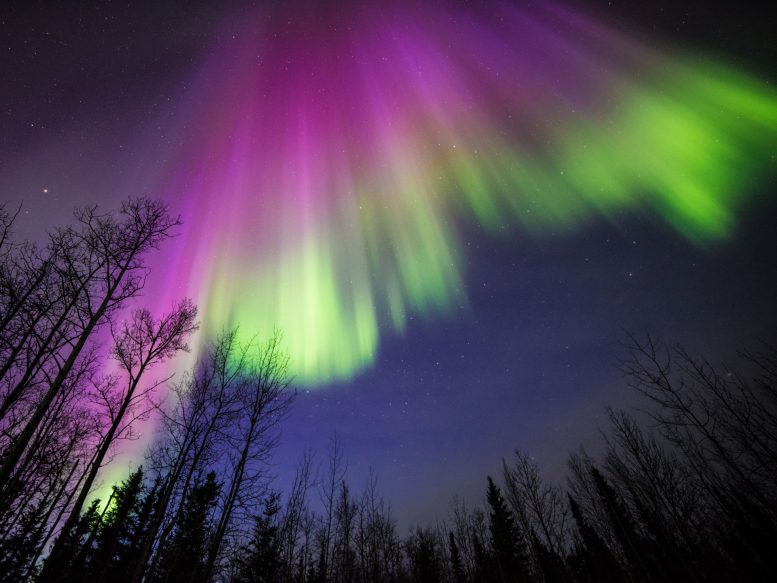
This image of a colorful aurora was taken in Delta Junction, Alaska, on April 10, 2015. All auroras are created by energetic electrons, which rain down from Earth’s magnetic bubble and interact with particles in the upper atmosphere to create glowing lights that stretch across the sky. Credit: Image courtesy of Sebastian Saarloos
Because the forces that generate Earth’s magnetic field are constantly changing, the field itself is also in continual flux, its strength waxing and waning over time. This causes the location of Earth’s magnetic north and south poles to gradually shift and to completely flip locations about every 300,000 years or so. You can learn why magnetic field polarity changes and shifts have no effect on climate on the timescales of human lifetimes and aren’t responsible for Earth’s recent observed warming here.
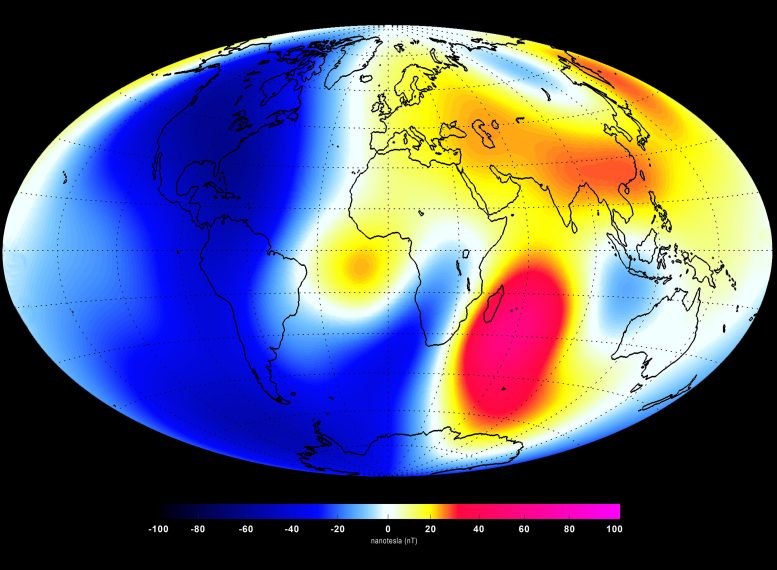
Launched in November 2013 by the European Space Agency (ESA), the three-satellite Swarm constellation is providing new insights into the workings of Earth’s global magnetic field. Generated by the motion of molten iron in Earth’s core, the magnetic field protects our planet from cosmic radiation and from the charged particles emitted by our Sun. It also provides the basis for navigation with a compass.
Based on data from Swarm, the top image shows the average strength of Earth’s magnetic field at the surface (measured in nanotesla) between January 1 and June 30, 2014. The second image shows changes in that field over the same period. Though the colors in the second image are just as bright as the first, note that the greatest changes were plus or minus 100 nanotesla in a field that reaches 60,000 nanotesla. Credit: European Space Agency/Technical University of Denmark (ESA/DTU Space)
To understand the forces that drive Earth’s magnetic field, it helps to first peel back the four main layers of Earth’s “onion” (the solid Earth):
- The crust, where we live, which is about 19 miles (31 kilometers) deep on average on land and about 3 miles (5 kilometers) deep at the ocean bottom.
- The mantle, a hot, viscous mix of molten rock about 1,800 miles (2,900 kilometers) thick.
- The outer core, about 1,400 miles (2,250 kilometers) thick and composed of molten iron and nickel.
- The inner core, a roughly 759-mile-thick (1,221-kilometer-thick) solid sphere of iron and nickel metals about as hot as the Sun’s surface.
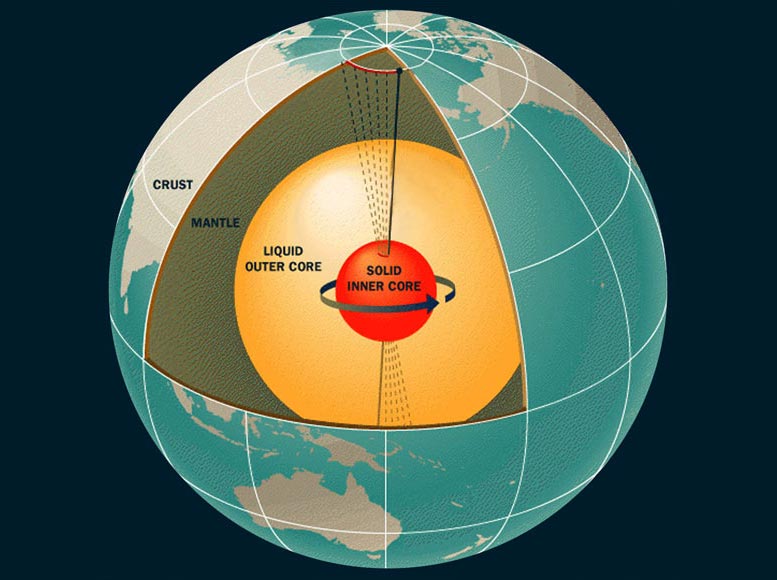
Earth’s internal structure: dense solid metallic core, viscous metallic outer core, mantle and silicate-based crust. Credit: NASA
Nearly all of Earth’s geomagnetic field originates in the fluid outer core. Like boiling water on a stove, convective forces (which move heat from one place to another, usually through air or water) constantly churn the molten metals, which also swirl in whirlpools driven by Earth’s rotation. As this roiling mass of metal moves around, it generates electrical currents hundreds of miles wide and flowing at thousands of miles per hour as Earth rotates. This mechanism, which is responsible for maintaining Earth’s magnetic field, is known as the geodynamo.
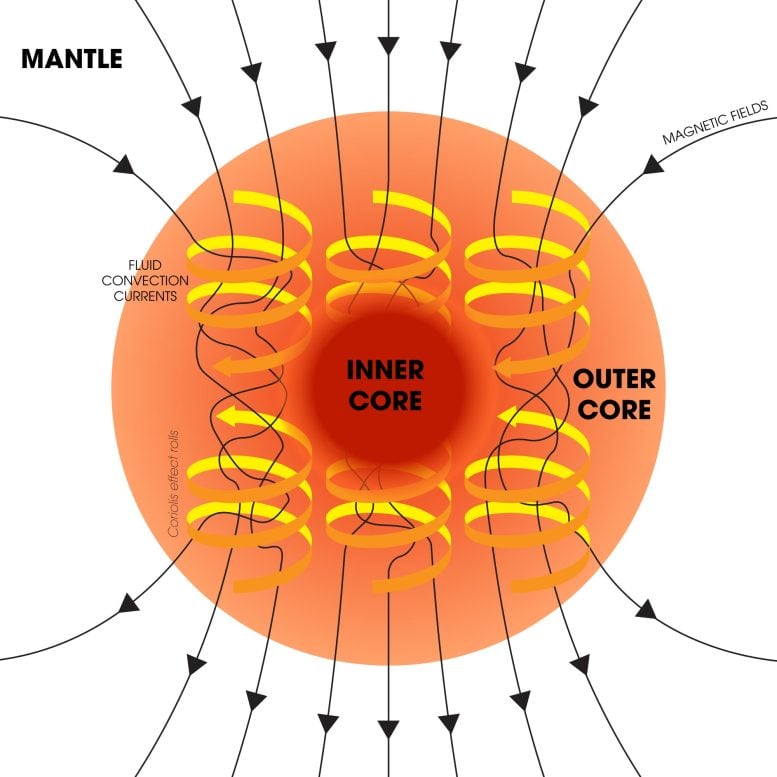
Illustration of the dynamo mechanism that creates Earth’s magnetic field: convection currents of fluid metal in Earth’s outer core, driven by heat flow from the inner core, organized into rolls by the Coriolis force, create circulating electric currents, which generate the magnetic field. Credit: Andrew Z. Colvin, CC BY-SA 4.0, via Wikimedia Commons
At Earth’s surface, the magnetic field forms two poles (a dipole). The north and south magnetic poles have opposite positive and negative polarities, like a bar magnet. The invisible lines of the magnetic field travel in a closed, continuous loop, flowing into Earth at the north magnetic pole and out at the south magnetic pole. The solar wind compresses the field’s shape on Earth’s Sun-facing side, and stretches it into a long tail on the night-facing side.
The study of Earth’s past magnetism is called paleomagnetism. Direct observations of the magnetic field extend back just a few centuries, so scientists rely on indirect evidence. Magnetic minerals in ancient undisturbed volcanic and sedimentary rocks, lake and marine sediments, lava flows and archeological artifacts can reveal the magnetic field’s strength and directions, when magnetic pole reversals occurred, and more. By studying global evidence and data from satellites and geomagnetic observatories and analyzing the magnetic field’s evolution using computer models, scientists can construct a history of how the field has changed over geologic time.
A simple visualization of Earth’s magnetosphere near the time of the equinox. Credit: NASA’s Scientific Visualization Studio
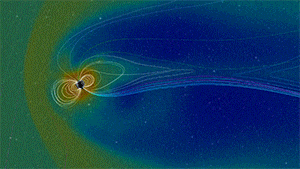
Earth is surrounded by a system of magnetic fields, called the magnetosphere. The magnetosphere shields our home planet from harmful solar and cosmic particle radiation, but it can change shape in response to incoming space weather from the Sun. Credit: NASA’s Scientific Visualization Studio
Earth’s mid-ocean ridges, where tectonic plates form, provide paleomagnetists with data stretching back about 160 million years. As lava continually erupts from the ridges, it spreads out and cools, and the iron-rich minerals in it align with the geomagnetic field, pointing north. Once the lava cools to about 1,300 degrees Fahrenheit (700 degrees Celsius), the strength and direction of the magnetic field at that time become “frozen” into the rock. By sampling and radiometrically dating the rock, this record of the magnetic field can be revealed.
Studies of Earth’s magnetic field have revealed much of its history.
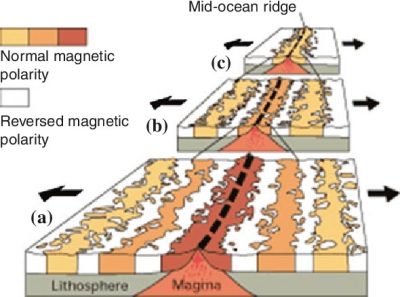
Magnetic stripes around mid-ocean ridges reveal the history of Earth’s magnetic field for millions of years. The study of Earth’s past magnetism is called paleomagnetism. Credit: USGS
For example, we know that over the past 200 years, the magnetic field has weakened about 9 percent on a global average. However, paleomagnetic studies show the field is actually about the strongest it’s been in the past 100,000 years, and is twice as intense as its million-year average.
We also know there’s a well-known “weak spot” in the magnetosphere that is present year-round. Located over South America and the southern Atlantic Ocean, the South Atlantic Anomaly (SAA) is an area where the solar wind penetrates closer to Earth’s surface. It’s created by the combined influences of the geodynamo and the tilt of Earth’s magnetic axis. While charged solar particles and cosmic ray particles within the SAA can fry spacecraft electronics, they don’t affect life on Earth’s surface.
We know the positions of Earth’s magnetic poles are continually moving. Since it was first precisely located by British Royal Navy officer and polar explorer Sir James Clark Ross in 1831, the magnetic north pole’s position has gradually drifted north-northwest by more than 600 miles (1,100 kilometers), and its forward speed has increased, from about 10 miles (16 kilometers) per year to about 34 miles (55 kilometers) per year.
Earth’s magnetic field acts like a protective shield around the planet, repelling and trapping charged particles from the Sun. But over South America and the southern Atlantic Ocean, an unusually weak spot in the field – called the South Atlantic Anomaly, or SAA – allows these particles to dip closer to the surface than normal. Currently, the SAA creates no visible impacts on daily life on the surface. However, recent observations and forecasts show that the region is expanding westward and continuing to weaken in intensity. The South Atlantic Anomaly is also of interest to NASA’s Earth scientists who monitor the changes in magnetic strength there, both for how such changes affect Earth’s atmosphere and as an indicator of what’s happening to Earth’s magnetic fields, deep inside the globe. Credit: NASA’s Scientific Visualization Studio
Earth’s magnetic poles are not the same as its geodetic poles, which most people are more familiar with. The locations of Earth’s geodetic poles are determined by the rotational axis our planet spins upon. That axis doesn’t spin evenly, like a globe on your desk. Instead, it wobbles slightly. This causes the position of the true north pole to shift slightly over time. Numerous processes on Earth’s surface and within its interior contribute to this wander, but it’s primarily due to the movement of water around Earth. Since observations began, the position of Earth’s rotational axis has drifted toward North America by about 37 feet (12 meters), though never more than about 7 inches (17 centimeters) in a year. These wobbles don’t affect our daily life, but they must be considered to get accurate results from global navigation satellite systems, Earth-observing satellites and ground observatories. The wobbles can tell scientists about past climate conditions, but they’re a consequence of changes in continental water storage and ice sheets over time, not a cause of them.
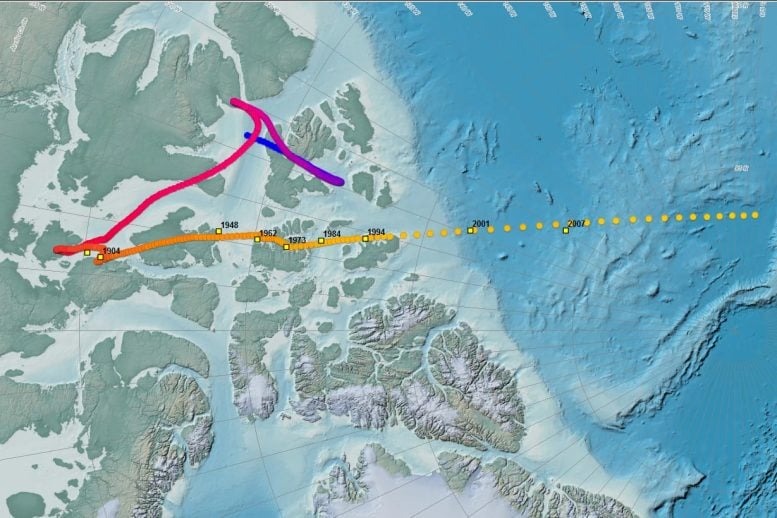
Observed north dip poles during 1831 – 2007 are yellow squares. Modeled pole locations from 1590 to 2020 are circles progressing from blue to yellow. Credit: NOAA/NCEI
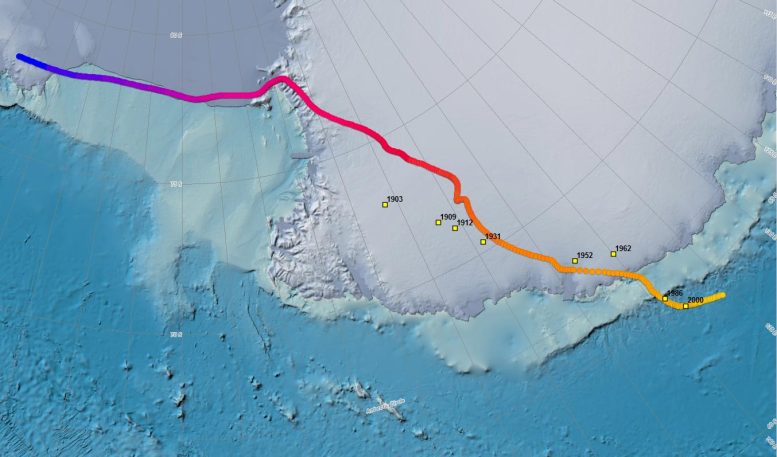
Observed south dip poles during 1903 – 2000 are yellow squares. Modeled pole locations from 1590 to 2020 are circles progressing from blue to yellow. Credit: NOAA/NCEI
By far the most dramatic changes impacting Earth’s magnetosphere are pole reversals. During a pole reversal, Earth’s magnetic north and south poles swap locations. While that may sound like a big deal, pole reversals are actually common in Earth’s geologic history. Paleomagnetic records, including those revealing variations in magnetic field strength, tell us Earth’s magnetic poles have reversed 183 times in the last 83 million years, and at least several hundred times in the past 160 million years. The time intervals between reversals have fluctuated widely, but average about 300,000 years, with the last taking place about 780,000 years ago. Scientists don’t know what drives pole reversal frequency, but it may be due to convection processes in Earth’s mantle.
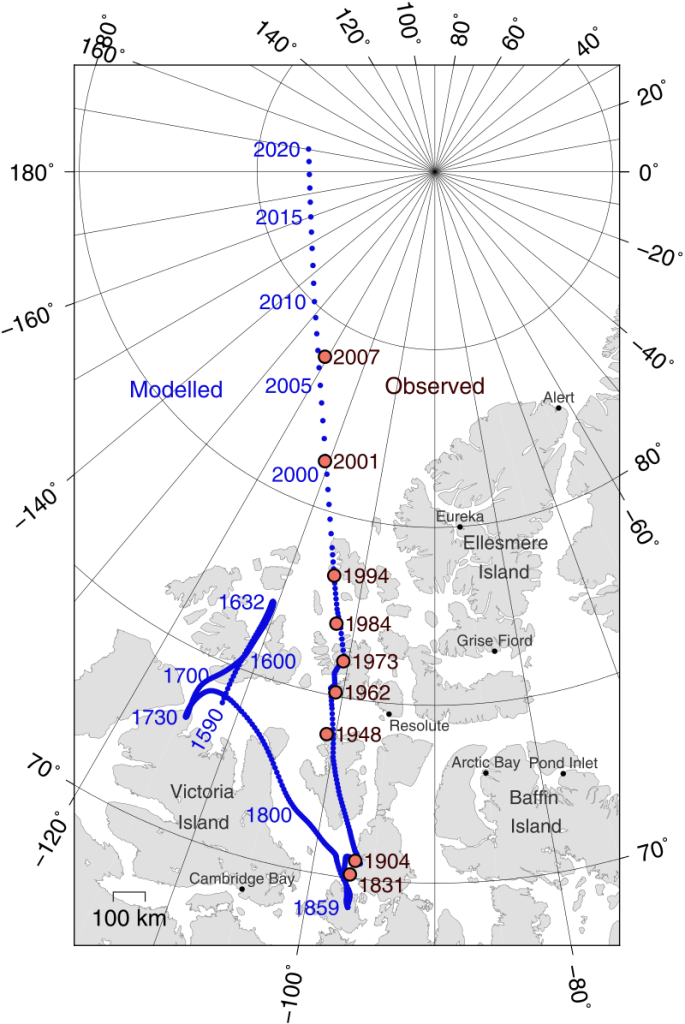
Positions of Earth’s North Magnetic Pole. Poles shown are dip poles, defined as positions where the direction of the magnetic field is vertical. Red circles mark magnetic north pole positions as determined by direct observation; blue circles mark positions modeled using the GUFM model (1590–1890) and the IGRF-12 model (1900–2020) in one-year increments. For the years 1890–1900, a smooth interpolation between the two models was performed. The modeled locations after 2015 are projections. Credit: Cavit, CC BY 4.0, via Wikimedia Commons
During a pole reversal, the magnetic field weakens, but it doesn’t completely disappear. The magnetosphere, together with Earth’s atmosphere, still continue to protect our planet from cosmic rays and charged solar particles, though there may be a small amount of particulate radiation that makes it down to Earth’s surface. The magnetic field becomes jumbled, and multiple magnetic poles can emerge at unexpected latitudes.
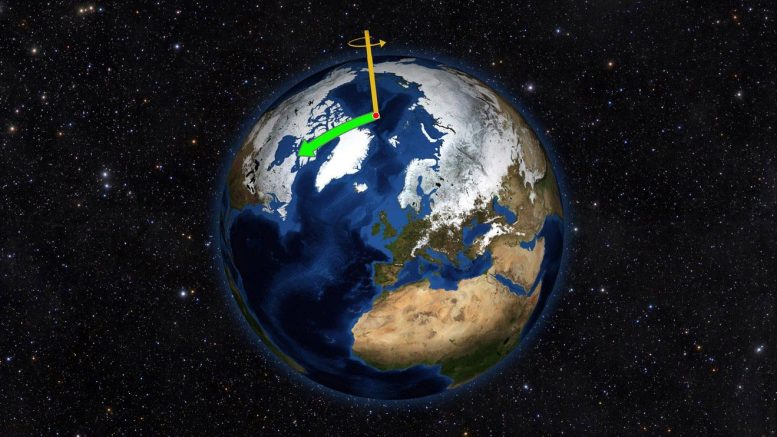
Earth does not always spin on an axis running through its poles. Instead, it wobbles irregularly over time, drifting toward North America throughout most of the 20th Century (green arrow). That direction has changed drastically due to changes in water mass on Earth. Credit: NASA/JPL-Caltech
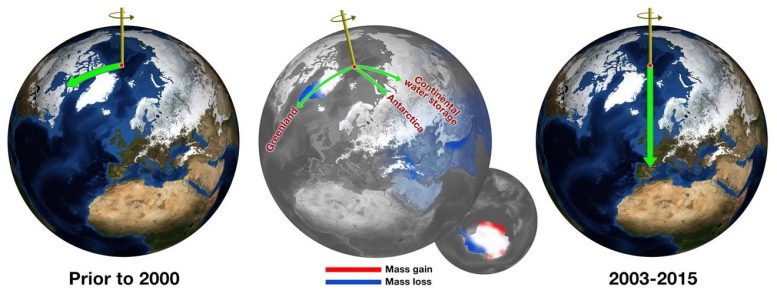
Before about 2000, Earth’s spin axis was drifting toward Canada (green arrow, left globe). JPL scientists calculated the effect of changes in water mass in different regions (center globe) in pulling the direction of drift eastward and speeding the rate (right globe). Credit: NASA/JPL-Caltech
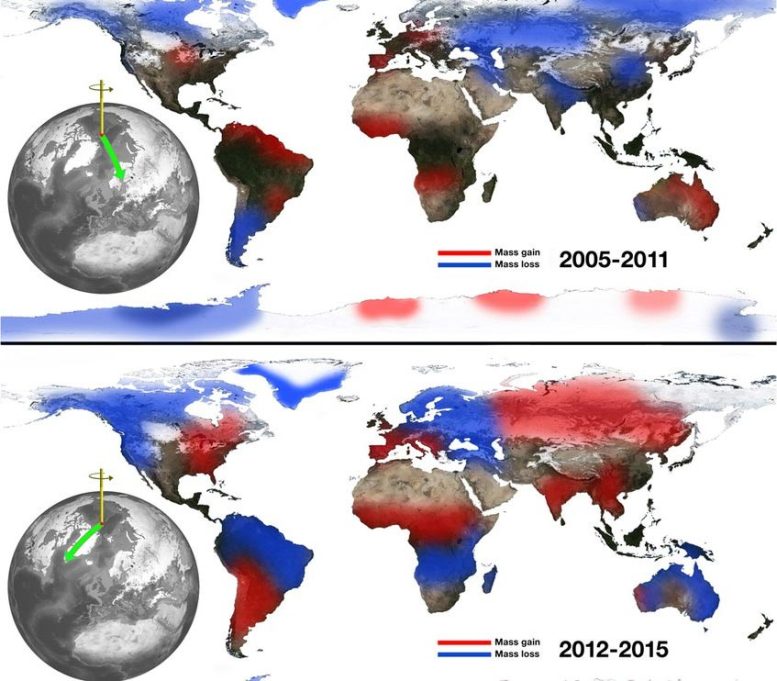
The relationship between continental water mass and the east-west wobble in Earth’s spin axis. Losses of water from Eurasia correspond to eastward swings in the general direction of the spin axis (top), and Eurasian gains push the spin axis westward (bottom). Credit: NASA/JPL-Caltech
No one knows exactly when the next pole reversal may occur, but scientists know they don’t happen overnight. Instead, they take place over hundreds to thousands of years. Scientists have no reason to believe a flip is imminent.

Geomagnetic polarity over the past 169 million years, trailing off into the Jurassic Quiet Zone. Dark areas denote periods of normal polarity, light areas denote reverse polarity.
Finally, there are “geomagnetic excursions:” shorter-lived but significant changes to the intensity of the magnetic field that last from a few centuries to a few tens of thousands of years. Excursions happen about 10 times as frequently as pole reversals. An excursion can re-orient Earth’s magnetic poles as much as 45 degrees from their previous position, and reduce the strength of the field by up to 20 percent. Excursion events are generally regional, rather than global. There have been three significant excursions in the past 70,000 years: the Norwegian-Greenland Sea event about 64,500 years ago, the Laschamps event between 42,000 and 41,000 years ago, and the Mono Lake event about 34,500 years ago.
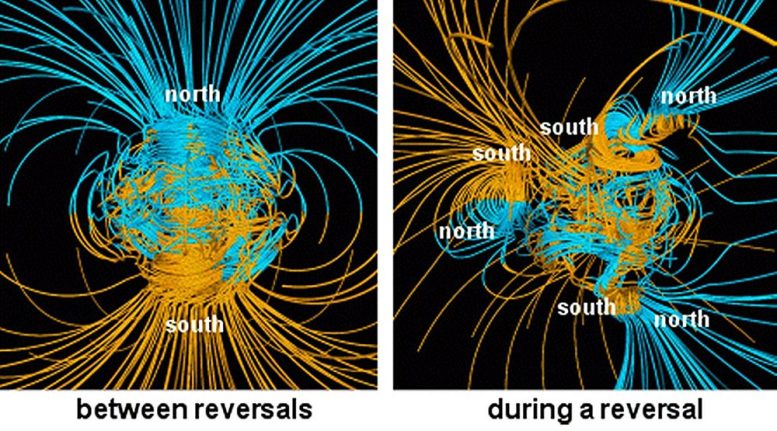
Supercomputer models of Earth’s magnetic field. On the left is a normal dipolar magnetic field, typical of the long years between polarity reversals. On the right is the sort of complicated magnetic field Earth has during the upheaval of a reversal. Credit: University of California, Santa Cruz/Gary Glatzmaier

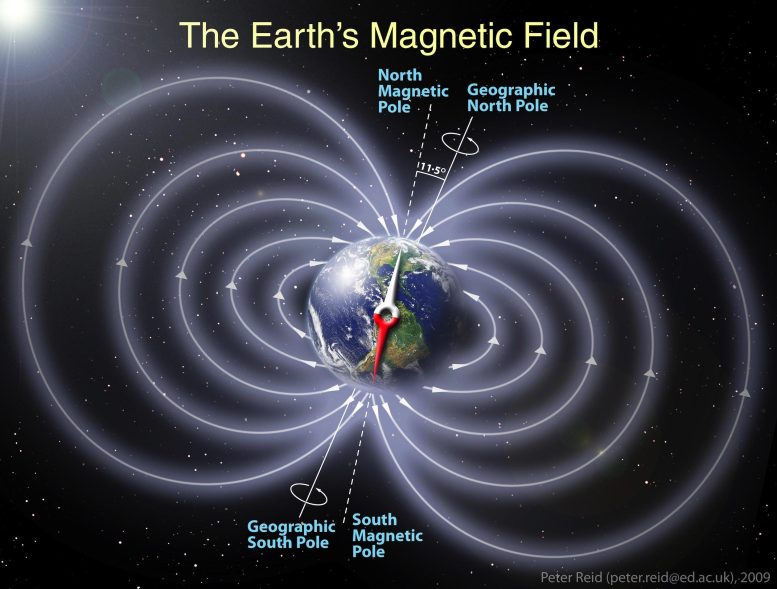
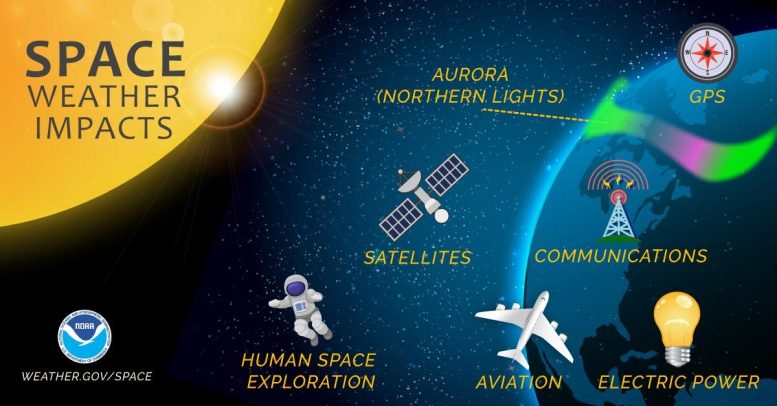
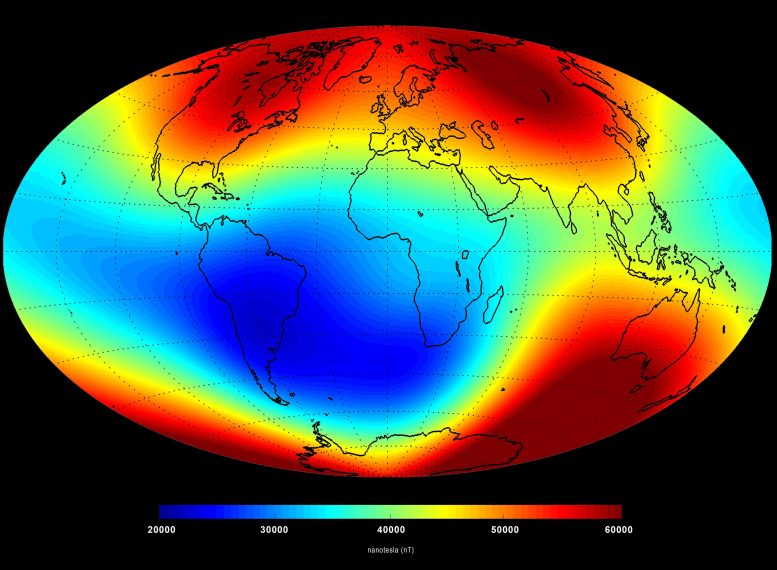





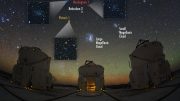
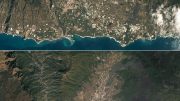

That’s what I was looking for, what an info present here at this website. https://www.tellthebell.run/
so for the record it states
take an iron bar magnet throw some iron filings on same the north pole arcs down to the south pole showing the magnetic line
so for the record the earth record states
take an earth 780,000 years old
last earth magnetic field north and south poles gradually shift and completely flip over may be due to convection processes in earths mantle
so now the north magnetic tip is in the south equator hemisphere and the magnetic loop exits the south pole and loops around 129 kilometres to enter the north pole hemisphere north pole polar area 2021
at earths surface the magnetic field forms two poles a dipole the north and the south magnetic poles have opposite positive and negative polarities like a bar magnet
the invisible lines of the magnetic field travel in the following line a closed continuous 100,000 kilometre loop flowing into earth at the north magnetic pole and
outwards at the south magnetic pole
is this credible i ask
and instead of bouncing around bouncing back and forth from pole to pole it must shoot straight down to the outer and inner iron nickle molten cores where the solid core acts as a superhot cooker plate energizing itself for perpetual motion levels of 5 billion years and then reenergized expels out into the magnetic field once again
and so the weakest point in the field
is where the earth southern hemisphere skids along the solar orbit path
so as the 100,000 kilometres wide and high solar winds reach the noon side of the magentic earth field they storm the equator front 46,000 kilometres out
but the earth magnetic buffer zone 7 kilometres deep repels them
there the suns advancing forces regroup and transforming themselves they launch themselves downwards towards the south pole region and
upwards towards the north pole region and
sidewards right to the dawn area of the planet earth sphere the proper motion of the planet earth advancing globe
and some sidewards left to the dusk area of the planet earth sphere the slipstream of the planet earth rear globe
and as they travel the tilt of the 23 degree earth exposes its weak spot at the base of the southern hemisphere an unusually weak spot in the magnetosphere that is present year round located over south america and the southern atlantic ocean the south atlantic anomaly saa where the solar wind blasts the earth at it lowest point perpendicular to its shear zone the area where the rubber tyre skids along the surface of the road where the earth skids along its orbital route
and that same tilt hides the north pole region from the full force of the solar wind blast as its polar hat is being blown at forehead height level but the top of its head is higher up and the solar winds are shearing here to cause aurora
and some of the high energy particles as they shear by enter the polar regions and make their way to energise the central solid iron nickle core heating up the solid cooker plate to energise the magnetic core once more to protect the earth
and othertimes the moon appears 390,000 kilometres out to act as a further protective barrier from this solar wind advancing force
so, as the magnetosphere shifts, so does the flux density of Van Allen over regions previously better protected by Van Allen. Why is the ‘seyence’ community not placing more emphasis on this process that mankind has no control of whatsoever, perhaps being a much more probable driver of solar energy absorption in Antarctica and other regions of the earth, than is this cocamamie idea that humans are causing the polar ice to melt?
anytime there’s an opportunity to blow smoke up everyone’s arse and render everyone ‘honorary chimneys’ vs seekers of real TRUTH, so taxes can be levied to ‘save the earth’ from something demonstrably outside of human control, it is almost always exploited in ‘fear mongering’ and disinformation that blames this on the relative ‘nuance’ of the industrialization of the earth which in fact really has been a tiny slice of time relative to time before industrialization when solar minimums and other processes outside of man’s control, altered the temperatures of regions of the earth and caused disruptions and even famines and mass die offs of animals. Given this, I’d have to wonder when TRUTH will rear it’s beautiful head and elucidate those who blindly trust the lamestream media and the lying governments to tell us the real TRUTH of what is really probably the case vs this ‘glow ball warming’ b.s. theory.